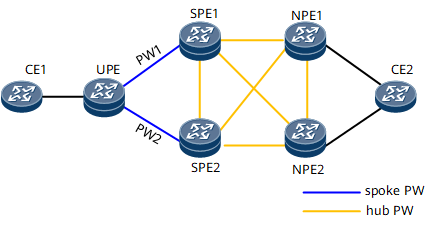(Optional) Associating the Spoke PW Status with Hub PW Status
After the spoke PW status is associated with the hub PW status, the spoke PW will go Down if the associated hub PWs go down, triggering an active/standby spoke PW switchover.
Context
In a VPLS PW redundancy scenario, if all the hub PWs of an SPE where the primary spoke PW resides go Down but the primary spoke PW is still Up, traffic still travels along the primary PW to the SPE. Because all hub PWs of the SPE go Down, the SPE drops the received traffic. To prevent this problem, associate the spoke PW status with the hub PW status. Then, after all the hub PWs of the SPE where the primary spoke PW resides go Down, the SPE instruct the UPE to switch traffic to the secondary spoke PW.

Procedure
- Run system-view
The system view is displayed.
- Run vsi vsi-name
The view of the created VSI is displayed.
- Run pwsignal ldp
The VSI-LDP view is displayed.
- Run peer (VSI-LDP view) peer-address [ negotiation-vc-id vc-id ] pw pw-name
The PW view is displayed.
- Run track hub-pw
The spoke PW status is associated with the hub PW status.
This command can only be used to configure spoke PWs to track the status of hub PWs. Therefore, a spoke PW must have been created using the peer (VSI-LDP view) peer-address [ negotiation-vc-id vc-id ] [ tnl-policy policy-name ] upe command.
After the track hub-pw command is configured, the SPE instructs the UPE to switch traffic to the secondary spoke PW after detecting that all connected hub PWs go Down. The protect-group group-name and protect-mode pw-redundancy master commands must have been run to create a PW protection group with the master/slave PW redundancy mode, and the primary and secondary PWs have been added to the group.
- Run commit
The configuration is committed.